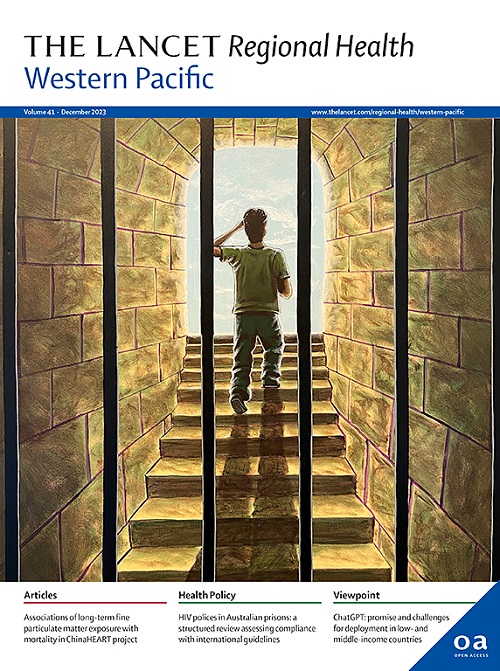INTERACT3研究中脑出血血肿引流的手术结果
IF 8.1
1区 医学
Q1 HEALTH CARE SCIENCES & SERVICES
引用次数: 0
摘要
背景:对于急性脑出血(ICH)患者的血肿清除手术干预是否有益,一直存在争议。本研究旨在评估第三次重症监护捆绑治疗急性脑出血降压试验(INTERACT3)参与者的6个月功能结局与手术干预以排出血肿的关系。方法:这是INTERACT3的二次分析,纳入发病后6小时内自发性脑出血的成人(年龄≥18岁)患者。INTERACT3是2017年12月12日至2021年12月31日期间在10个国家的121家医院进行的一项国际性、多中心、前瞻性、楔步式、聚类随机、盲法结局评估的临床试验。为了限制结果的异质性,我们将分析限制在中国的参与者。在6个月时,主要结局是功能不良,以改良Rankin量表(mRS)的5-6分来定义。次要结局包括mRS评分4-6分和6个月死亡率。敏感性分析包括倾向评分匹配分析和缺失结果变量的归算。我们还评估了手术时间对手术结果的影响。INTERACT3试验已在ClinicalTrials.gov (NCT03209258)和CHiCTR.org.cn (chictr - oc -17011787)注册。结果:在中国82个地区的5772名参与者(平均年龄62.0±12.5岁)中,1411名(24.4%)接受了手术,其中开颅手术是最常见的方法(72.6%)。在对混杂变量进行校正后,6个月时,手术排出血肿与较低的功能不良结局(优势比0.71,95% CI 0.55 - 0.92; p = 0.010)和死亡率(优势比0.55,95% CI 0.40-0.75; p = 0.0001)相关。倾向性评分匹配分析和归算敏感性分析结果一致。我们没有发现在到达医院当天接受手术的患者与在第二天或更晚接受手术的患者在结果上有显著差异。在仅限于幕上脑出血和血肿容量为30ml或更多的参与者的分析中,血肿的清除与较低的功能不良结局的几率(n = 1234,优势比0.68,95% CI 0.46-0.99; p = 0.042)和死亡率(n = 1291, or 0.45, 95% CI 0.29-0.69; p = 0.0003)相关。对INTERACT3的二次分析表明,血肿的清除与急性脑出血后无严重残疾存活的更好机会相关。随着仪器和技术的发展,进一步的试验应解决血肿引流在深部脑出血患者中的作用,时间窗和微创技术的差异。由卫生和社会保障部、外交、联邦和发展办公室、医学研究理事会和威康信托基金资助的全球联合健康试验(JGHT)资助计划;华西医院1-3-5优秀学科发展计划;澳大利亚国家卫生和医学研究委员会;四川信科药业;武田(中国)。本文章由计算机程序翻译,如有差异,请以英文原文为准。
Surgical outcomes from haematoma evacuation for intracerebral haemorrhage in the INTERACT3 study
Background
There is ongoing controversy as to whether surgical intervention to haematoma evacuation benefits patients with acute intracerebral haemorrhage (ICH). This study aimed to evaluate the association of surgical intervention to evacuate the haematoma and 6-month functional outcome in participants of the third Intensive Care Bundle with Blood Pressure Reduction in Acute Cerebral Haemorrhage Trial (INTERACT3).
Methods
This was a secondary analysis of INTERACT3, which enrolled adults (age ≥18 years) spontaneous ICH patients within 6 h after onset. INTERACT3 was an international, multicentre, prospective, stepped-wedge, cluster randomised, blinded outcome assessed, clinical trial undertaken at 121 hospitals in 10 countries between December 12, 2017 and December 31, 2021. To limit heterogeneity in the results, we restricted analyses to participants in China. The primary outcome was poor functional outcome, defined by a score of 5–6 on the modified Rankin scale (mRS), at 6 months. Secondary outcomes include a mRS score of 4–6 and mortality at 6 months. Sensitivity analysis included propensity score matched analysis and the imputation of missing outcome variables. The effect of timing on surgical outcome was also evaluated. The INTERACT3 trial was registered at ClinicalTrials.gov (NCT03209258) and CHiCTR.org.cn (ChiCTR-IOC-17011787).
Findings
Of 5772 participants (mean age 62.0 ± 12.5 years) at 82 sites in China, 1411 (24.4%) received surgery in which craniotomy (72.6%) was the most common approach. After adjustment for confounding variables, surgery to evacuate the haematoma was associated with lower odds of a poor functional outcome (odds ratio 0.71, 95% CI 0.55–0.92; p = 0.010) and mortality (odds ratio 0.55, 95% CI 0.40–0.75; p = 0.0001) at 6 months. The association was consistent in propensity score matching analysis and sensitivity analysis by imputation. We did not detect significant differences in outcome between those who received surgery on the same day of hospital arrival compared to those who received surgery on the second or later days. In analysis limited to participants with supratentorial ICH and with a haematoma volume 30 mL or more, evacuation of the haematoma was associated with lower odds of poor functional outcome (n = 1234, odds ratio 0.68, 95% CI 0.46–0.99; p = 0.042) and mortality (n = 1291, OR 0.45, 95% CI 0.29–0.69; p = 0.0003).
Interpretation
This secondary analysis of the INTERACT3 indicates that evacuation of the haematoma is associated with better chances of surviving free of severe disability after acute ICH. With the evolution of instrument and techniques, further trial should address the role of haematoma evacuation in deep ICH patients, the time window and difference between mini-invasive techniques.
Funding
Joint Global Health Trials (JGHT) funding scheme from the Department of Health and Social Care, the Foreign, Commonwealth & Development Office, the Medical Research Council and Wellcome Trust; the West China Hospital Outstanding Discipline Development 1–3-5 programme; National Health and Medical Research Council of Australia; Sichuan Credit Pharmaceutical; and Takeda (China).
求助全文
通过发布文献求助,成功后即可免费获取论文全文。
去求助
来源期刊

The Lancet Regional Health: Western Pacific
Medicine-Pediatrics, Perinatology and Child Health
CiteScore
8.80
自引率
2.80%
发文量
305
审稿时长
11 weeks
期刊介绍:
The Lancet Regional Health – Western Pacific, a gold open access journal, is an integral part of The Lancet's global initiative advocating for healthcare quality and access worldwide. It aims to advance clinical practice and health policy in the Western Pacific region, contributing to enhanced health outcomes. The journal publishes high-quality original research shedding light on clinical practice and health policy in the region. It also includes reviews, commentaries, and opinion pieces covering diverse regional health topics, such as infectious diseases, non-communicable diseases, child and adolescent health, maternal and reproductive health, aging health, mental health, the health workforce and systems, and health policy.
 求助内容:
求助内容: 应助结果提醒方式:
应助结果提醒方式:


